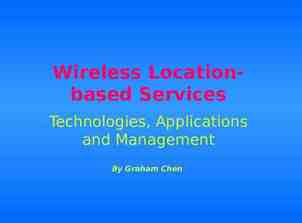Developing a conflict-sensitive business approach Audience B:
47 Slides3.38 MB
Developing a conflict-sensitive business approach Audience B: Detailed training for Community Relations Professionals
Aims and objectives of this session In this session we’ll explore: What do we mean by conflict? Why is conflict relevant to business? What is the business case for developing a conflict-sensitive approach? What does this mean in practice? Further resources 2 www.icmm.com Follow us
Exercise What examples do you have of conflict associated with your department and/or operation? In what way has it affected your operation or department, and you personally? 3 www.icmm.com Follow us
What do we mean by “conflict”?
What do we mean by conflict? “At it's simplest, it is any tension or disagreement between people or institutions. At its most extreme, it is a full scale war fought between or within states. It covers arguments and atrocities, simple quarrels, and mass killings. But conflict is really a consequence. It is what happens when disagreements are not resolved or interests are considered incompatible. Violent conflict is what happens when one or more parties conclude that the only, or the most effective, means of advancing their agenda is through violence.” Scoping paper: Mining and Conflict. Prepared for ICMM (2013) 5 www.icmm.com Follow us
The nature of conflict Conflict exists along a continuum (disagreements to full scale war) Conflict is a consequence – based on actual/perceived incompatibility Inherent in humanity, part of life, inevitable Conflict can be a source of change and force for positive change Varies in intensity, depending on size of incompatibility and response Varies in form, dependent on many wider factors Only some conflicts become violent. 6 www.icmm.com Follow us
The relevance of conflict to business
The two-way dimension of conflict The company may cause impacts which contribute to conflict, or may exacerbate pre-existing conflict/tension Conflict can impact a company/project, with a variety of costs 8 www.icmm.com Follow us
Potential interaction between project and conflict 9 The company causes SOCIAL IMPACTS that contribute to conflict The conflict causes SOCIAL IMPACTS that affect the company Resettlement leads to a deepening of power imbalances within a community. Large proportion of youth become militarised and intimidate local staff. Hiring policy inadvertently privileges staff from one ethnic group, causing resentment in others. Populations dislocated by conflict lose access to livelihoods and steal from the company, or try to generate income by kidnapping staff. The company causes ENVIRONMENTAL IMPACTS that contribute to conflict The conflict causes ENVIRONMENTAL IMPACTS that affect the company Company use of land leads to competition among previous land users for access. Scorched earth tactics of conflict actors damage operations. Damage to sacred sites of indigenous people fuels state/community conflict. Conflict actors target oil fields, pipelines or other structures, causing spills. www.icmm.com Follow us
Common key social risk areas and flashpoints Vulnerabilities for companies and communities Artisanal mining Corruption and transparency Environmental issues Company operations Stakeholder engagement Dealing with armed groups Social investments Employment issues Human rights Indigenous Peoples Unions Compensation 10 Security www.icmm.com Resettlement Follow us
Incidents of conflict over time 2002 2003 2004 2005 2006 2007 2008 2009 Total all sources Total BHRRC 2010 2011 2012 2013 2014 2015 0 20 40 60 80 100 Number of incidents 11 www.icmm.com Follow us 120
Causes of conflict 2015 ASM Consultation Corporate power Corruption Economic Environmental Health and safety Underlying Primary Indigenous issues Labour Land issues Resettlement Security issue Use of force Water 0 12 1 2 3 4 5 6 7 www.icmm.com 8 Follow us 9 10
The business case for adopting a conflict-sensitive approach
The consequences of conflict on the company Lost productivity: protests, blockades, sabotage, etc. Lost opportunity: aborted greenfield investments, decision not to pursue the purchase/sale/expansion of existing operations Lost time: senior management involvement, additional staff time, legal advice Lost reputation: international campaigns, litigation. 14 Communities also suffer the consequences of conflict. www.icmm.com Follow us
The direct costs of conflict to business Direct costs Example Security Higher payments to state/private security firms; staff time spent on security management. Risk management Insurance, loss of coverage, specialist training for staff, reduced mobility and higher transport costs. Material Destruction of property or infrastructure. Opportunity Disruption of production, delays on imports; aborted greenfield investments or expansions. Time Senior management involvement, additional staff time, legal advice. Capital Increased cost of raising capital. Personnel Kidnapping, killing and injury; stress; recruitment difficulties; higher wages to offset risk; cost of management time spent protecting staff. Reputation Consumer campaigns, risk-rating, share price, competitive loss. Litigation Expensive and damaging law suits. 15 www.icmm.com Follow us
The indirect costs of conflict to business Indirect costs Example Human Loss of life, health, intellectual and physical capacity. Social Weakening of social capital. Economic Damage to financial and physical infrastructure, loss of markets. Environment Pollution, degradation, resource depletion. Political Weakening of institutions, rule of law, governance. 16 www.icmm.com Follow us
A conflict-sensitive approach to business
Tools that support a conflict-sensitive approach (1 of 2) Operational guidance charts These link the typical project cycles of oil and gas or mining investments to the relevant elements of Conflict-Sensitive Business Practice Guidance and other recommended actions. Screening tool A rapid assessment to identify key conflict issues early in the pre-investment phase Provides an initial analysis of the country and its conflict dynamics and flags key issues of concern Identifies the level of risk as well as showstoppers. 18 www.icmm.com Follow us
Tools that support a conflict-sensitive approach (2 of 2) 19 Macro-level Conflict Risk and Impact Assessment tool (MCRIA) Project-level Conflict Risk and Impact Assessment tool (PCRIA) An expert-led context analysis on national and regional level Explores issues of concern raised in screening Identifies potential interactions of projects with these issues. Deeper analysis of potential interactions between a project and its context Includes processes for participatory analysis and decision-making with stakeholders Helps to build trust and design shared actions that build peace. www.icmm.com Follow us
Key components of a conflict-sensitive approach Comprehensive contextual understanding of conflict (existing and potential) Two-way understanding of conflict impacts Conflict-specific management strategies Identifying stakeholders and informing engagement strategies Building stakeholder support for the project 20 www.icmm.com Follow us
A model for analysing conflict in support of a business-sensitive approach Causes, drivers and triggers Components of conflict analysis Context and issues 21 Actors and dynamics www.icmm.com Follow us
Framing conflict-sensitivity within the PDCA&E cycle Analysing the context, assessing impacts & risks, developing responses Integrate findings Communicate & engage throughout Ensure organisational readiness & take action Track effectiveness, monitor and report 22 www.icmm.com Follow us
Adjust Plan Engage Understanding your context and impacts Planning Check Do
Planning: Understanding your context and identifying issues Features of the project-level profile 24 www.icmm.com Follow us
Planning: Identifying conflict actors (1 of 2) 25 www.icmm.com Follow us
Planning: Identifying conflict actors (2 of 2) A conflict map simplifies a conflict and presents: 1. The actors, their “power, or influence on the conflict 2. Their relationship with each other 3. The conflict theme or issues. 26 www.icmm.com Follow us
Exercise: Experimenting with a conflict map 1. Select a conflict situation (or similar) that is currently playing out between your company and stakeholders – limit yourself to ten stakeholders, including company. NOTE: Size of circle drawn amount of power of the stakeholder. 27 2. Using the SEAT Tool 4C legend as a guide, illustrate the following between stakeholders: Close relationships Strong alliances Weak, informal links Discord or conflict Broken connections/relationships The predominant direction of the influence or activity Note the conflict theme or issue that separates them or connects them. www.icmm.com Follow us
Moving onto identification of impacts Exploring causes, drivers and triggers 28 www.icmm.com Follow us
Exercise: Using the ‘Problem Tree’ For one unresolved conflict situation/issue, identify: The trunk (the name and nature of the conflict) (e.g. tensions between fishing community and pastoralists) The roots: the root causes/structural factors of conflict (e.g. poverty, ethnic prejudice, corruption) The branches and leaves: the manifestations/effects of the problems (e.g. conflicts between ex-combatants and host communities, land disputes of returning refugees) The trigger: single key events (or their anticipation) that can set off or trigger conflict. . and RISKS to your company from the conflict. Capture your answers on a flipchart, and feed back to group. 29 www.icmm.com Follow us
Exercise: Using the ‘Peace Flower’ For one peace situation, identify: The centre of the flower/it’s name: the peace issue (e.g. good company/community relations) Roots: the root causes/systemic factors which support peace (e.g. access to resources) Stem: processes in place (e.g. strong community structures) Petals: on-going peace efforts (e.g. open lines of communication between company and community). Then, identify the key learning which can be replicated/transferred to promote peace elsewhere in relation to your company and associated communities (possibly in a situation where tension currently exists or has the potential to arise?). Capture your answers on a flipchart, and feed back to group. 30 www.icmm.com Follow us
Exercise: Supporting material to help identify causes, drivers and triggers Can be internal and/ external Root cause Anglo American, SEAT 3, Tool 4C (developed by International Alert) 31 www.icmm.com Follow us
Exercise: Supporting material for different categories of causes and drivers Anglo American, SEAT 3, Tool 4C (developed by International Alert) 32 www.icmm.com Follow us
Adjust Plan Engage An on-going activity throughout the conflict assessment and conflict management process Engagement Check Do
The benefits of engagement during conflict analysis Engaging stakeholders does two key things: 1. Build transparent relationships 2. Build project support. A deepened understanding, of the different ways people are affected, allows for better conflict sensitivity. 34 www.icmm.com Follow us
The role of engagement in conflict-sensitive business practice “Early, consistent, meaningful and empowering stakeholder engagement processes lie at the core of a conflict-sensitive business approach.” 35 www.icmm.com Follow us
Adjust Plan Engage Developing and implementing conflict-sensitive approaches Management responses Check Do
Strategies for managing company conflict impacts Pea cebuil ding “Do no harm” Compliance 37 Proactively contributing to a more stable environment Develop measures to avoid creating or worsening conflict With national legislation and internationally agreed laws and standards. www.icmm.com Follow us
Mitigation guidance through a conflict lens A company’s conflict mitigation strategies should: Address all aspects of business impact Address real needs at the local level Be sustainable Avoid creating a dependency culture by simply providing services Consider and address the wider structural issues underpinning the conflict Ensure participatory design of mitigation strategies. 38 www.icmm.com Follow us
The key elements in a management plan Issue/ Impact List the issue that needs management. 39 Management Objective The objective/ goal that the operation wishes to achieve by managing each issue. Management Measure The action that needs to do/put in place in order to meet the objective and manage the issue. Performance Target The concrete targets that the operation wishes to achieve through the management measure/s. Responsibility The individual/s or department /s responsible for implementing the monitoring measure. Timing The deadline for implementation of the management measure, and if appropriate, the frequency for implementation of management measure. www.icmm.com Follow us Resources The resources required (monetary, staff etc.) to carry out the management measure. KPIs The data source to measure effectiveness of the management measure, and to check if manageme nt objective has been met.
What to do in situations of high tension (1 of 2) Show compassion and empathy Even when the issue raised is not the responsibility of the company Be candid about the operation’s room for manoeuvre on key issues Identify areas where the operation can genuinely show flexibility Be honest and transparent Including about what you can’t talk about Acknowledge any past errors Stress actions taken versus defending those that were not taken Stress the operation’s willingness to be accountable Acknowledge and record issues or concerns Demonstrate a willingness to respond to the issues raised This includes ensuring that the appropriate personnel are available to respond. 40 www.icmm.com Follow us
What to do in situations of high tension (2 of 2) Do not provide excessively technical information in your responses “I don’t care what you know, until I know that you care” Be personable and reasonable Tension is easier to resolve when the approach is personal. (e.g. “we’re sorry” instead of “The Company regrets”) Keep your own emotions in check 41 www.icmm.com Follow us
Adjust Plan Engage Tracking performance and making changes Monitoring and adjusting Check Do
Monitoring KPIs should be developed in relation to: 1. Causes of conflict 2. Manifestations of conflict 3. Effectiveness of preventative or mitigation measures. 43 www.icmm.com Follow us
In conclusion: An overview Conflict is inevitable, and can be a force for positive change It should therefore not be avoided at all costs However, conflict has negative consequences for both business and associated communities A conflict-sensitive approach is thus essential This understanding forms the basis of your interventions. 44 At the heart of this approach is meaningful stakeholder engagement, and developing an understanding of the conflict - the context, issues, stakeholders, and company’s role in the conflict. www.icmm.com Follow us
The benefits of this approach 45 Improved companycommunity relations More informed management responses and risk management Tracking of risks across the project life cycle Warning system for weaknesses in existing risk management Improved security of personnel, facilities and communities. www.icmm.com Follow us
Further resources The following resources are helpful: Anglo American, SEAT 3, Tool 4C Conflict Assessment and Management (2012) ICMM In-Brief: Research on Company-community Conflict (2015) ICMM: Understanding Company-Community Relations Toolkit (2015) International Alert: Conflict-Sensitive Business Practice: Guidance for Extractive Industries (2005) International Alert: Red Flags: Liability risks for companies operating in high risk zones (2008) 46 www.icmm.com Follow us
International Council on Mining and Metals (ICMM) 35/38 Portman Square London W1H 6LR United Kingdom Switchboard: 44 (0) 20 7467 5070 Main Fax: 44 (0) 20 7467 5071 E-mail: [email protected] www.icmm.com




















































